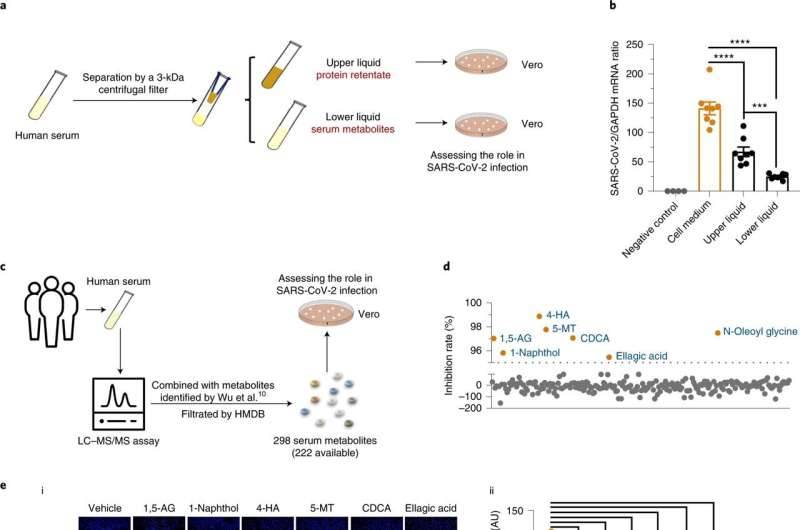Screening of human serum metabolites against SARS-CoV-2 infection. a,b, Roles of human serum metabolites in SARS-CoV-2 infection. Schematic diagram of the study design (a). Incubation with human serum-derived filtrates impaired SARS-CoV-2 replication (b). Negative control: cells incubated with cell medium without SARS-CoV-2 infection. For the upper liquid group and lower liquid group, each dot represents one donor (n = 8 healthy donors). P = 0.0001 for upper liquid versus lower liquid, P < 0.0001 for cell medium versus upper liquid, cell medium versus lower liquid. c,d, Identification of the human serum metabolite(s) that prevent SARS-CoV-2 infection. Schematic diagram of the screening experimental design (c). The role of human serum metabolite(s) in SARS-CoV-2 infection (d). The amount of viral RNA was normalized to human GAPDH. The dot is the mean value. e, Assessing the antiviral activities of six metabolites from human serum by immunofluorescence staining. The nucleocapsid was stained with Alexa Fluor 546-conjugated anti-rabbit IgG (red). The nuclei were stained with To-Pro-3 iodide (blue). The stained cells were examined using a Zeiss LSM 880 meta confocal microscope in multitrack mode (i). Representative of three confocal immunofluorescence images from three biological replicates was shown. Scale bars, 20 μm. (ii) Mean fluorescence intensity in differently treated cells. Three images stained with nucleocapsid and Alexa Fluor 546-conjugated anti-rabbit IgG individually selected from three biological replicates were used to determine the mean fluorescence intensity with ImageJ (National Institutes of Health). AU, arbitrary units. P < 0.0001 for vehicle versus 1,5-AG, vehicle versus 1-napthol, vehicle versus 4-HA, vehicle versus 5-MT, vehicle versus CDCA, vehicle versus ellagic acid. f,g, Measurement of the half maximal inhibitory concentration (IC50) of these candidate metabolites. Half maximal inhibitory concentrations of these metabolites (f). The viral loads in the cell supernatant were detected with a plaque-formation assay at 40 h post-infection. The gray dotted line represents the 50% inhibition ratio (n = 3 biological independent samples). Biological characterizations of candidate metabolic component(s) (g). Data are presented as the mean ± s.e.m. (b,e,f). Data were analyzed using a two-tailed Student's t-test. P values were adjusted using Dunnett's test. ***P < 0.001, ****P < 0.0001. Experiments were performed independently at least three biological replicates with comparable results. Credit: Nature Metabolism (2022). DOI: 10.1038/s42255-022-00567-z
A team of researchers affiliated with a large number of institutions in China, has found that low concentrations of a certain metabolite in diabetic patients may explain why they are more susceptible to COVID symptoms. In their paper published in the journal Nature Metabolism, the group describes their work in searching for and comparing metabolites in people with and without diabetes and then how they tested incubated cells from them against a SARS-CoV-2 infection and what they learned by doing so.
Not long after the global pandemic began, doctors began noticing that some people were more susceptible to more extreme symptoms when infected, and one of those groups included people who had diabetes. In this new effort, the researchers have found what they believe is a likely reason for that.
To find out why diabetics were more susceptible to COVID, the researchers conducted a search of metabolites that differed between people with and without diabetes. In so doing, they found 484, of which 222 have been created artificially and are dispensed commercially. The researchers incubated samples of all 222 of the metabolites and then exposed them to samples of the SARS-CoV-2 virus.
In so doing, they noted which if any reduced the ability of the virus to infect other cells because they were binding with the metabolite instead. That narrowed the list of metabolites down to seven and further testing reduced it to just one: 1,5-AG. The researchers note that, when produced in the body, it is filtered into the kidneys and reabsorbed into the blood. But in people with diabetes, the reabsorption does not work as well and it winds up in their urine, which means they have less of it in their blood.
In testing infection rates of cells mixed with 1,5-AG, the researchers found higher loads of viral infection in cases where 1,5-AG levels were lower. They also found that artificially adding sera containing 1,5-AG to cell mixes resulted in lowered viral load levels. The researchers also tried giving diabetic mouse models serum with 1,5-AG mixed in and found that doing so resulted in lowered viral loads after infection.
The researchers suggest their work indicates that lower levels of 1,5-AG in diabetic patients is the reason they are more susceptible to symptoms from SARS-CoV-2. More work will need to be done, however, to determine if giving such patients serum with 1,5-AG can reduce their symptoms.
More information: Liangqin Tong et al, A glucose-like metabolite deficient in diabetes inhibits cellular entry of SARS-CoV-2, Nature Metabolism (2022). DOI: 10.1038/s42255-022-00567-z
Journal information: Nature Metabolism
© 2022 Science X Network
























